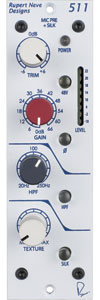
Rupert Neve Designs has produced a number of signature products that bring Mr. Neve’s touch to the modern age of recording. While the price of these products are out of the reach for some, the newest offering from RND hits the affordability target dead center while maintaining quality and excellent sonics. The 511 preamp features a range of controls plus the signature Silk circuit.
RND has elegantly optimized the space constraints of the 500 Series by using components that maintain a low noise floor with the same presence and sonics of their popular Portico series. A precision 12-way rotary switch increases the gain from 0 to 66 dB in 6dB steps. An additional sweepable trim knob creates a continuously variable ±6dB level control, and there are phase polarity and phantom power buttons included on the 511 panels. A variable highpass filter is engaged by pressing the HPF switch, allowing the user to sweep from 20-250 Hz at a rate of a 12dB octave to eliminate low-end rumble when needed.
The eight-step LED meter on the right side of the Portico 511 becomes bright once signal passes and will hold a peak in the red range depending on how far above the clip threshold the incoming signal is. The Silk button found on the Portico II series is included on the 511—pushing the red button engages the red Silk circuit, which reduces the negative feedback on the output transformer, adding harmonic content as the texture is increased. The Silk circuit itself allows the engineer to create roughly 10 times the amount of harmonic content and distortion characteristics found with many of Rupert Neve’s earlier Class-A vintage designs.
Great Things, Small Packages
The pair of 511 units sent for review slotted easily into my API 6b 500 Series rack. I ran some test tones through them to make sure they were calibrated evenly. The pair matched up perfectly and off to the studio they went. I first used them on a drum bus, as I love to add a bit of preamp color for some harmonic depth when I mix. The 511s sounded great on the kick and snare alone—full, clear and present. I started to push the preamp section by adding increments until they started to break up, similar to a 1960s drum break. I could see this being very useful for a particular sound or project; the distortion color was very musical and useful. I then backed it off to get back to what I started with and engaged the Silk button to test the color it would add. I dropped in the rest of the kit and began rolling in varied amounts of Silk. It easily re-creates the similar harmonic content of my favorite 1073, and the drums felt a bit fuller and more muscular overall.
Since the 511s shined on an insert, I expected more of the same once I brought them into a tracking session. I used them on a session with Nashville trans-Western rock duo the Blackfoot Gypsies. I placed one of the 511s in the guitar line with a Royer 121, one of my favorite guitar mics. The tone coming out of the amp was a classic British overdrive, and the combination of the 511 and the Royer 121 captured it perfectly. I moved the mic around to get the right depth of field from the cabinet and room, and I then engaged the highpass filter to roll off some of the rumble.
After the first pass, we laid down double to fatten up the guitar part. On the second pass, I engaged the Silk button and went at the signal aggressively. The Silk texture brought the midrange and upper midrange forward significantly, and created a bit more edge to the second track. I applied the same technique to the solo but rolled the highpass up even further. Again, the Silk texture aided in getting the solo out front and smoothed out the tone coming off the amp. I was not having to work hard at all to achieve killer guitar sounds with no EQ, and was really loving what the Silk was adding.
Contrast and Compare
Over the next few weeks I tried the 511s on a variety of sources with great results. Having them in a 500 Series rack made it easy to get what I was looking for, as I typically like to have a Neve-type pre everywhere I work. The 511s worked well on loud sources like drums and electric guitars, as well as on acoustic guitar and quiet vocal passes. I was recording a delicate high-string acoustic and found my Vintech v73i a bit too noisy for how soft the incoming signal was. I patched in the 511, and the guitar player immediately commented on how he couldn’t hear the pre in his headphones any longer.
I wanted to track some direct bass for a TV commercial project, and wished that the 511 had a ¼-inch input on the front panel for easy access, and possibly a mic/line button. I know that space is limited inside the pre, and I ended up using a turnaround to interface the XLR input on the back. The bass had plenty of bottom and I ended up pushing the pre a bit harder to get the bass to sit in nicely with the drums.
I had done a few comparisons to the other Class-A and tube pre’s in my studio, and then wanted to try the 511s against some other Neve-type clones. I chose the Avedis MA5s preamps for my overheads, as I like the way they react with a pair of Mojave MA200 tube mics or the Royer SF12 stereo ribbon. The 511s were similar to the MA5s, but I preferred having the highpass filter and onboard metering of the 511s. Although RND preamps go from -6db to 72dB, and can take a full +26dB before clipping, the drummer was quite the hitter, so I found myself wanting a pad on the 511s, but ended up putting a -10dB pad on the mic lines.
Adding the Silk really brought out the transients in the overall kit and created a full overall picture without any other mics engaged. The 511s fared equally as well on kick, snare and toms when auditioned against a set of Daking preamps. The upright piano and the 511s became fast friends with a set of Coles 4038s. A Hammond B3 also shined through the 511s with a pair of Mojave MA301 FETs. I set the mics in figure-8, opened up the Silk knob, and the room became an important part of the take, adding vibe without being intrusive. The 511 on a vocal with a Sony C-800G tube mic gave a balance to the vocalist’s higher range while enhancing his lower register. This was a great choice for rock vocalists as it handles louder and gritty voices really well.
Tried and True
The more time I spent with the Rupert Neve Designs Portico 511 preamps, the more I enjoyed listening to them. I want a pair. The entire package is expertly thought through from an internal design perspective, and the front panel is super-clean and easy to use. Sonically, the 511 sounds great on nearly anything you put through it, working equally well with loud and soft sources. The Silk texture takes you closer to Neve’s vintage designs so you’re able to achieve the best of modern and classic approaches.
There are many imitators, but there is only one Rupert Neve, and my love for his signature sound has never dwindled. I’m glad to see that Mr. Neve is still trying to improve on his own ideas, and I certainly look forward to hearing what comes next.
Chris Grainger (itsgrainger.com) is a producer/mixer/engineer and owner of Undertow Studio in Nashville.
Try This
Take a matched pair of your favorite condensers or ribbon mics and plug them into a pair of the 511s. Drive the preamps to achieve the sound you’re after. Place one 40 inches above the center of the snare and centered on the kick drum pedal; place the other mic on the right side facing the drummer. Adjust that mic to achieve the proper balance of the kit. Add a kick and snare input of your choice and try to re-create the drum sound that Glyn Johns made famous on many of my favorite records from the ’60s and ’70s with minimal inputs.
Product Summary
COMPANY: Rupert Neve Designs
PRODUCT: Portico 511 Preamp
WEBSITE:rupertneve.com
PRICE: $545
PROS: Rupert Neve’s design. The quiet Silk texture adds rich harmonic content. Great price.
CONS: No ¼-inch input. No input pad.






